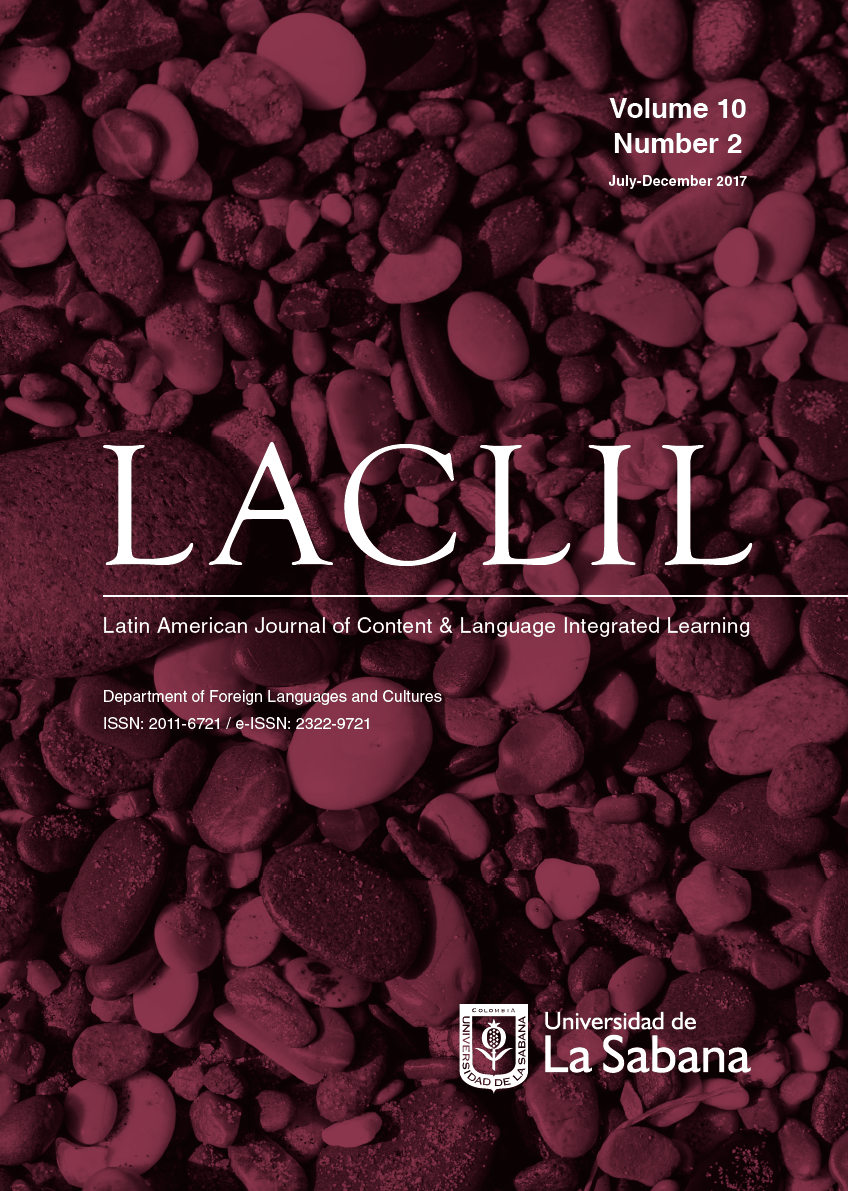The Road to Bilingualism: Cases of Success
Keywords:
Bilingualism, content and language, CLIL, understanding by design, 21st century skillsAbstract
This review presents an immersion model based on the ideas of Richard-Amato regarding task-based approach, and how it was adapted to Wiggin’s Understanding by Design and 21st Century skills frameworks. This combination has nurtured and helped the immersion model to arise, where the content and language areas are responsible for the cognitive and communicative development in a learner. The institution recognizes itself as an alternative educational solution for its students, and periodically revises its policies to meet the needs that can emerge in their community. Thus, the immersion model applied in the institution has emerged as a flexible, yet well-grounded and solid program that aims to make the most of the content in different areas to help students develop their foreign language skills in English.
Downloads
References
Arabski, J. editor, & Wojtaszek, A. editor. (2011). Aspects of culture in second language acquisition and foreign language learning / editado por Janusz Arabski y Adam Wojtaszek. Berlin : Springer.
Council of Europe. (2001). the Common European Framework of Reference for Languages : Learning, Teaching, Assessment. Council of Europe, 1–273. https://doi.org/10.1017/S0267190514000221
Coyle, D., Hood, P., & Marsh, D. (2010). CLIL Content and Language integrated learning. United Kingdom: Cambridge University press.
Dinero. (2017). Los mejores colegios en inglés, según Saber 11. Retrieved from http://www.dinero.com/contenidos-editoriales/mejores-colegios-2016/articulo/los-mejores-colegios-en-ingles-segun-saber-11-2016/239327
Harrop, E. (2012). Content and language integrated learning (CLIL): limitations and possibilities. Encuentro, (Clil), 57–70. https://doi.org/10.1080/09571730685200121
Khalid, M. S., Sutoyo, E., Mungad, M., Sari, E. N., & Herawan, T. (2014). Teaching and Learning using Computers: How should We Tread on Its’ Changing Technology? International Journal of Emerging Technologies in Learning (iJET), 9(5), 45–53. https://doi.org/10.3991/ijet.v9i5.3943
Masrizal, M. (2013). NATIVE VS NON-NATIVE ENGLISH TEACHERS. Jurnal Ilmiah Didaktika: Media Ilmiah Pendidikan Dan Pengajaran, 13(2). https://doi.org/10.22373/jid.v13i2.473
Ministerio de Educación Nacional. (2013). Orientaciones Para La Implementacion De Proyectos De Fortalecimiento Del Ingles En Las Entidades Territoriales (Vol. XXXIII). https://doi.org/10.1007/s13398-014-0173-7.2
National Education Association. (2014). Preparing 21st Century Students for a Global Society: An Educator ’ s Guide to the “ Four Cs ,” 1–38.
NATO. (2015). Language Level Equivalences Nato International Staff Nato Is Nato Is Levels1, 1, 2015.
Richard-Amato, P. (1988). Making It Happen: Interaction in The Second Language Classroom: From Theory To Practice (Longman). New York: Longman.
Stryker, S. B., & Leaver, B. Lou. (1997). Content-Based Instruction in Foreign Language Education : Models and Methods. Washington, D.C.: Georgetown University Press. Retrieved from http://search.ebscohost.com/login.aspx?direct=true&db=nlebk&AN=21648&lang=es&site=ehost-live&scope=site
Vazquez, M. (1990). A longitudinal study of cohort academic success and bilingual education. (C. Brinkley-Carter, Ed.). ProQuest Dissertations Publishing .
Wiggins, G. P. (2005). Understanding by Design, Expanded 2nd ed. (J. McTighe, Ed.), Understanding by Design. Alexandria : Alexandria Association for Supervision and Curriculum Development.
Yurtseven, N., & Altun, S. (2017). Understanding by Design (UbD) in EFL Teaching: Teachers’ Professional Development and Students’ Achievement *. Kuram ve Uygulamada Egitim Bilimleri, 17(2), 437–461. https://doi.org/http://dx.doi.org/10.12738/estp.2017.2.0226
Downloads
Published
How to Cite
Issue
Section
License
This Journal and its articles are published under the Creative Commons CC BY 4.0 DEED Attribution 4.0 International license. You are free to: Share — copy and redistribute the material in any medium or format for any purpose, even commercially. Adapt — remix, transform, and build upon the material for any purpose, even commercially. The license cannot revoke these freedoms as long as you follow the terms of the license.




